Comparing Accuracy of Three Methods Based on the GIS Environment for Determining Winching Areas
Abstract
1. Introduction
2. Materials and Methods
2.1. Study Areas
2.1.1. Fibbino
2.1.2. San Martino al Cimino
2.2. Preliminary Field Reliefs
2.3. GIS Implementation
2.3.1. Correct Distance Method (CDM)
2.3.2. Real Distance Buffer Method (RDBM)
2.4. Field Relief for Method Evaluation and Statistical Analysis
3. Results
3.1. Accessible Areas
3.1.1. Fibbino
3.1.2. San Martino al Cimino
3.2. Field Test
3.2.1. Fibbino
3.2.2. San Martino al Cimino
3.2.3. Comparison of Tested Methods
4. Discussion
5. Conclusions
Author Contributions
Funding
Acknowledgments
Conflicts of Interest
References
- Cambi, M.; Certini, G.; Fabiano, F.; Foderi, C.; Laschi, A.; Picchio, R. Impact of wheeled and tracked tractors on soil physical properties in a mixed conifer stand. IForest 2016, 9, 89–94. [Google Scholar] [CrossRef]
- Picchio, R.; Magagnotti, N.; Sirna, A.; Spinelli, R. Improved winching technique to reduce logging damage. Ecol. Eng. 2012, 47, 83–86. [Google Scholar] [CrossRef]
- Picchio, R.; Spina, R.; Calienno, L.; Venanzi, R.; Lo Monaco, A. Forest operations for implementing silvicultural treatments for multiple purposes. Ital. J. Agron. 2016, 11, 156–161. [Google Scholar]
- Enache, A.; Pentek, T.; Ciobanu, V.D.; Stampfer, K. GIS based methods for computing the mean extraction distance and its correction factors in Romanian mountain forests. Šumar. List 2015, 1–2, 35–46. [Google Scholar]
- Gumus, S.; Turk, Y. A New Skid Trail Pattern Design for Farm Tractors Using Linear Programing and Geographical Information Systems. Forests 2016, 7, 306. [Google Scholar] [CrossRef]
- Laschi, A.; Neri, F.; Brachetti Montorselli, N.; Marchi, E. A Methodological Approach Exploiting Modern Techniques for Forest Road Network Planning. Croat. J. For. Eng. 2016, 37, 319–331. [Google Scholar]
- Tucek, J.; Pacola, E. Algorithms for skidding distance modelling on a raster digital terrain model. J. For. Eng. 1999, 10, 67–79. [Google Scholar]
- Parsakhoo, A.; Mostafa, M. Road network analysis for timber transportation from a harvesting site to mills (Case study: Gorgan county–Iran). J. For. Sci. 2015, 61, 520–525. [Google Scholar] [CrossRef]
- Vopenka, P.; Kašpar, J.; Marušák, R. GIS tool for optimization of forest harvest-scheduling. Comput. Electr. Agric. 2015, 113, 254–259. [Google Scholar] [CrossRef]
- Segura, M.; Ray, D.; Maroto, C. Decision support systems for forest management: A comparative analysis and assessment. Comput. Electr. Agric. 2014, 101, 55–67. [Google Scholar] [CrossRef]
- Akay, A.E.; Sessions, J. Roading and transport operations. In Encyclopedia of Forest Sciences; Burley, J., Evans, J., Youngquist, J., Eds.; Elsevier Academic Press: Amsterdam, The Netherlands, 2004; pp. 259–269. [Google Scholar]
- Corona, P.; Ascoli, D.; Barbati, A.; Bovio, G.; Colangelo, G.; Elia, M.; Garfì, V.; Iovino, F.; Lafortezza, R.; Leone, V.; et al. Integrated forest management to prevent wildfires under Mediterranean environments. Ann. Silvic. Res. 2015, 39, 1–22. [Google Scholar]
- Enache, A.; Ciobanu, V.D.; Kühmaier, M.; Stampfer, K. An Integrative Decision Support Tool for Assessing Forest Road Options in a Mountainous Region in Romania. Croat. J. For. Eng. 2013, 34, 43–60. [Google Scholar]
- Grigolato, S.; Pellegrini, M.; Cavalli, R. Temporal analysis of the traffic loads on forest road networks. IForest 2013, 6, 255–261. [Google Scholar] [CrossRef]
- Hayati, E.; Majnounian, B.; Abdi, E. Qualitative evaluation and optimization of forest road network to minimize total costs and environmental impacts. IForest 2012, 5, 121–125. [Google Scholar] [CrossRef]
- Ezzati, S.; Najafi, A. Compilation of GIS and environmental techniques in primary forest road locating [In Farsi]. In Proceedings of the GIS Conference, Tehran, Iran, 6–7 January 2009; p. 10. [Google Scholar]
- Mederski, P.S.; Venanzi, R.; Bembenek, M.; Karaszewski, Z.; Rosińska, M.; Pilarek, Z.; Luchenti, I.; Surus, M. Designing Thinning Operations in 2nd Age Class Pine Stands—Economic and Environmental Implications. Forests 2018, 9, 335. [Google Scholar] [CrossRef]
- Magagnotti, N.; Spinelli, R.; Güldner, O.; Erler, J. Site impact after motor-manual and mechanised thinning in Mediterranean pine plantations. Biosyst. Eng. 2012, 113, 140–147. [Google Scholar] [CrossRef]
- Mederski, P.S. A comparison of harvesting productivity and costs in thinning operations with and without midfield. For. Ecol. Manag. 2006, 224, 286–296. [Google Scholar] [CrossRef]
- Picchio, R.; Neri, F.; Maesano, M.; Savelli, S.; Sirna, A.; Blasi, S.; Baldini, S.; Marchi, E. Growth Effects of Thinning Damage in a Corsican Pine (Pinus Laricio Poiret) Stand in Central Italy. For. Ecol. Manag. 2011, 262, 237–243. [Google Scholar] [CrossRef]
- Marchi, E.; Picchio, R.; Spinelli, R.; Verani, S.; Venanzi, R.; Certini, G. Environmental impact assessment of different logging methods in pine forests thinning. Ecol. Eng. 2014, 70, 429–436. [Google Scholar] [CrossRef]
- Gumus, S.; Hatay, T.Y. A cost effectiveness approach for configuration of feasible skyline yarder for specific forest regions. Fresenius Environ. Bull. 2017, 26, 4656–4662. [Google Scholar]
- Maesano, M.; Picchio, R.; Lo Monaco, A.; Neri, F.; Lasserre, B.; Marchetti, M. Productivity and energy consumption in logging operation in a Cameroonian tropical forest. Ecol. Eng. 2013, 57, 149–153. [Google Scholar] [CrossRef]
- Venanzi, R.; Picchio, R.; Piovesan, G. Silvicultural and logging impact on soil characteristics in Chestnut (Castanea sativa Mill.) Mediterranean coppice. Ecol. Eng. 2016, 92, 82–89. [Google Scholar] [CrossRef]
- Caliskan, E.; Karahalil, U. Evaluation of forest road network and determining timber extraction system using GIS: A case study in Anbardag planning unit. Šumar. List 2017, 3–4, 163–171. [Google Scholar]
- Picchio, R.; Pignatti, G.; Marchi, E.; Latterini, F.; Benanchi, M.; Foderi, C.; Venanzi, R.; Verani, S. The Application of Two Approaches Using GIS Technology Implementation in Forest Road Network Planning in an Italian Mountain Setting. Forests 2018, 9, 277. [Google Scholar] [CrossRef]
- Trimble. Juno Sb Handheld. Available online: https://www.trimble.com/mappinggis/junos.aspx (accessed on 30 September 2018).
- QGIS Development Team. QGIS Geographic Information System. Open Source Geospatial Foundation Project. 2017. Available online: http://www.qgis.org/ (accessed on 30 September 2018).
- Tarquini, S.; Isola, I.; Favalli, M.; Mazzarini, F.; Bisson, M.; Pareschi, M.T.; Boschi, E. TINITALY/01: A new Triangular Irregular Network of Italy. Ann. Geophys. 2007, 50, 407–425. [Google Scholar]
- Tarquini, S.; Vinci, S.; Favalli, M.; Doumaz, F.; Fornaciai, A.; Nannipieri, L. Release of a 10-m resolution DEM for the Italian territory: Comparison with global-coverage DEMs and anaglyph mode exploration via the web. Comput. Geosci. 2012, 38, 168–170. [Google Scholar] [CrossRef]
- Pentek, T.; Picman, D.; Potocnik, I.; Dvorscak, P.; Nevecerel, H. Analysis of an existing forest road network. Croat. J. For. Eng. 2005, 26, 39–50. [Google Scholar]
- Bembenek, M.; Giefing, D.F.; Karaszewski, Z.; Mederski, P.S.; Szczepańska-Álvarez, A. Tree damage in lowland spruce stands caused by early thinnings. Sylwan 2013, 157, 747–753. [Google Scholar]
- Fardusi, M.J.; Chianucci, F.; Barbati, A. Concept to practices of geospatial information tools to assist forest management & planning under precision forestry framework: A review. Ann. Silvic. Res. 2017, 41, 3–14. [Google Scholar]
- Scholz, J.; De Meyer, A.; Marques, A.S.; Pinho, T.M.; Boaventura-Cunha, J.; Van Orshoven, J.; Rosset, C.; Künzi, J.; Kaarle, J.; Nummila, K. Digital Technologies for Forest Supply Chain Optimization: Existing Solutions and Future Trends. J. Environ. Manag. 2018, 62, 1108–1133. [Google Scholar] [CrossRef]
- Bembenek, M.; Giefing, D.F.; Karaszewski, Z.; Mederski, P.S.; Szczepańska-Álvarez, A. Tree damage in lowland spruce stands because of late thinning. Sylwan 2013, 157, 892–898. [Google Scholar]
- Bakinowska, E.; Mederski, P.S.; Szczepańska-Alvarez, A.; Karaszewski, Z.; Bembenek, M. The parallel application of two probability models. logit and probit for the accurate analysis of spruce timber damage due to thinning operations. Drewno 2016, 59, 49–59. [Google Scholar] [CrossRef]
- Picchio, R.; Tavankar, F.; Bonyad, A.; Mederski, P.S.; Venanzi, R.; Nikooy, M. Detailed analysis of residual stand damage due to winching on steep terrains. Small-Scale For. 2018, in press. [Google Scholar]
- Talbot, B.; Pierzchała, M.; Astrup, R. Applications of remote and proximal sensing for improved precision in forest operations. Croat. J. For. Eng. 2017, 38, 327–336. [Google Scholar]
- Carballido, J.; Perez-Ruiz, M.; Emmi, L.; Aguera, J. Comparison of positional accuracy between rtk and rtx gnss based on the autonomous agricultural vehicles under field conditions. Appl. Eng. Agric. 2014, 30, 361–366. [Google Scholar]
- Macrì, G.; Zimbalatti, G.; Proto, A.R. Measuring the mobility parameters of tree-length forwarding systems using GPS technology in the Southern Italy forestry. Agronomy 2016, 14, 836–845. [Google Scholar]
- Marchi, E.; Chung, W.; Visser, R.; Abbas, D.; Nordfjell, T.; Mederski, P.S.; McEwan, A.; Brink, M.; Laschi, A. Sustainable Forest Operations (SFO): A new paradigm in a changing world and climate. Sci. Total Environ. 2018, 634, 1385–1397. [Google Scholar] [CrossRef]
- Picchio, R.; Sirna, A.; Sperandio, G.; Spina, R.; Verani, S. Mechanized harvesting of eucalypt coppice for biomass production using high mechanization level. Croat. J. For. Eng. 2012, 33, 15–24. [Google Scholar]
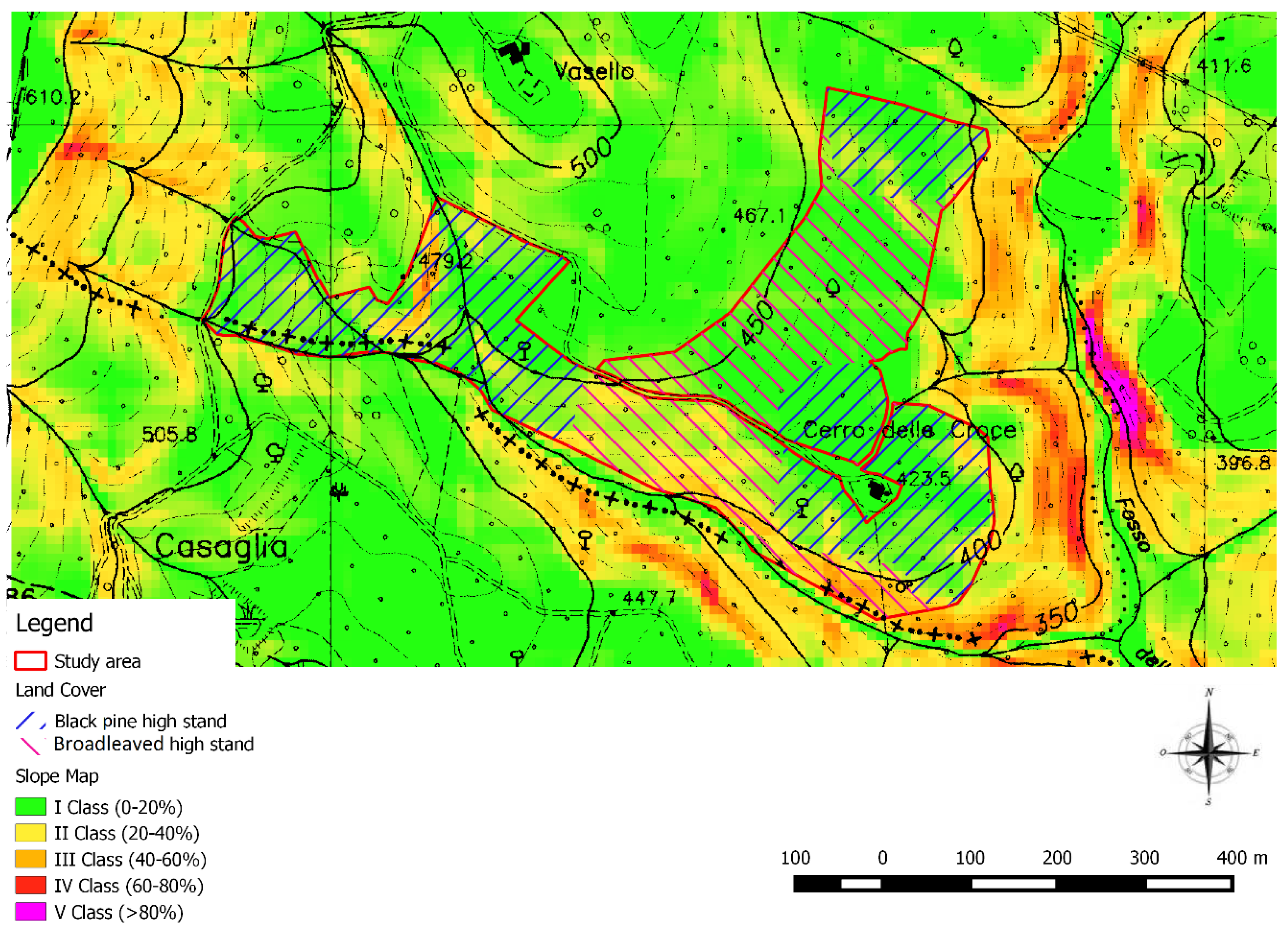
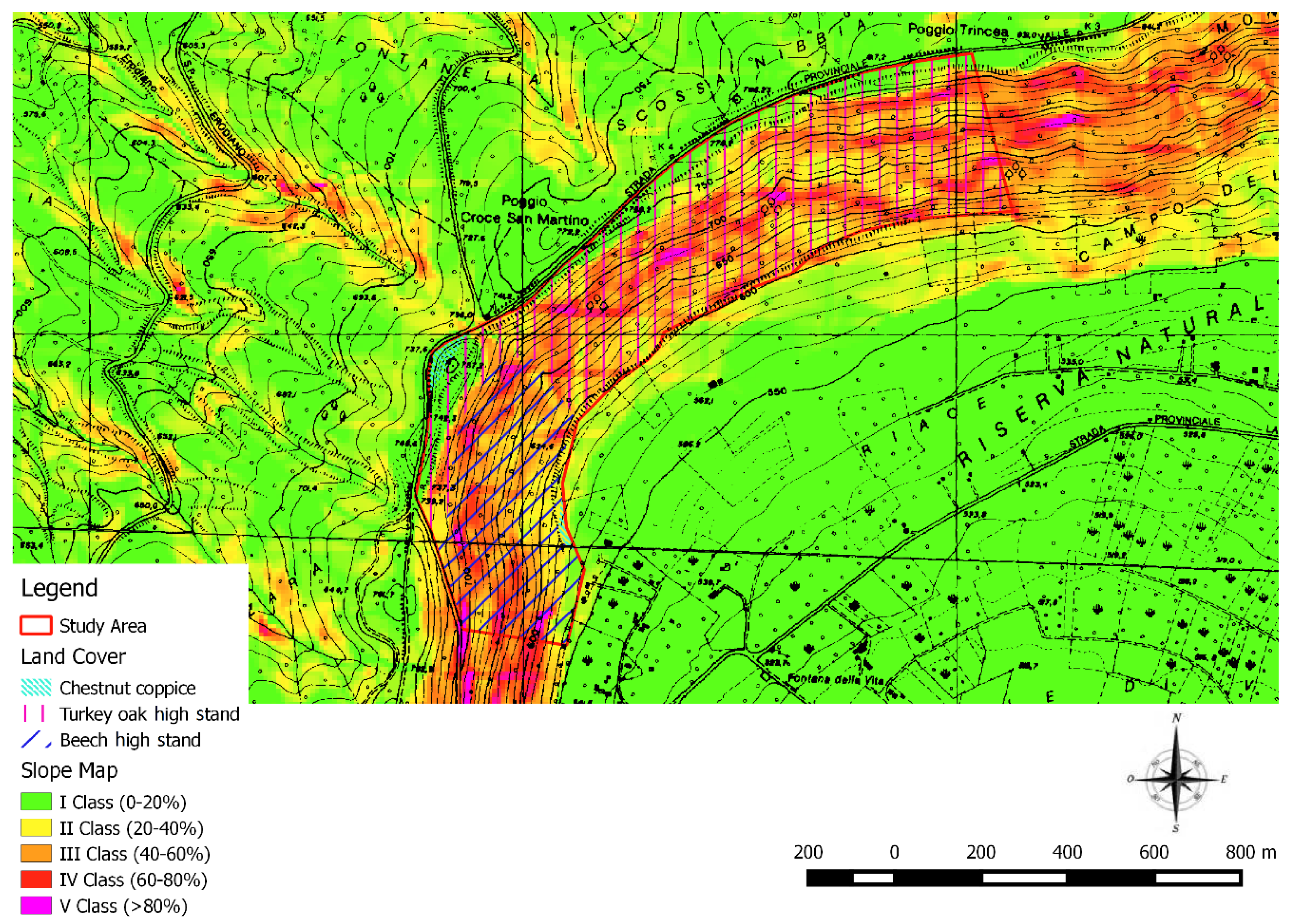
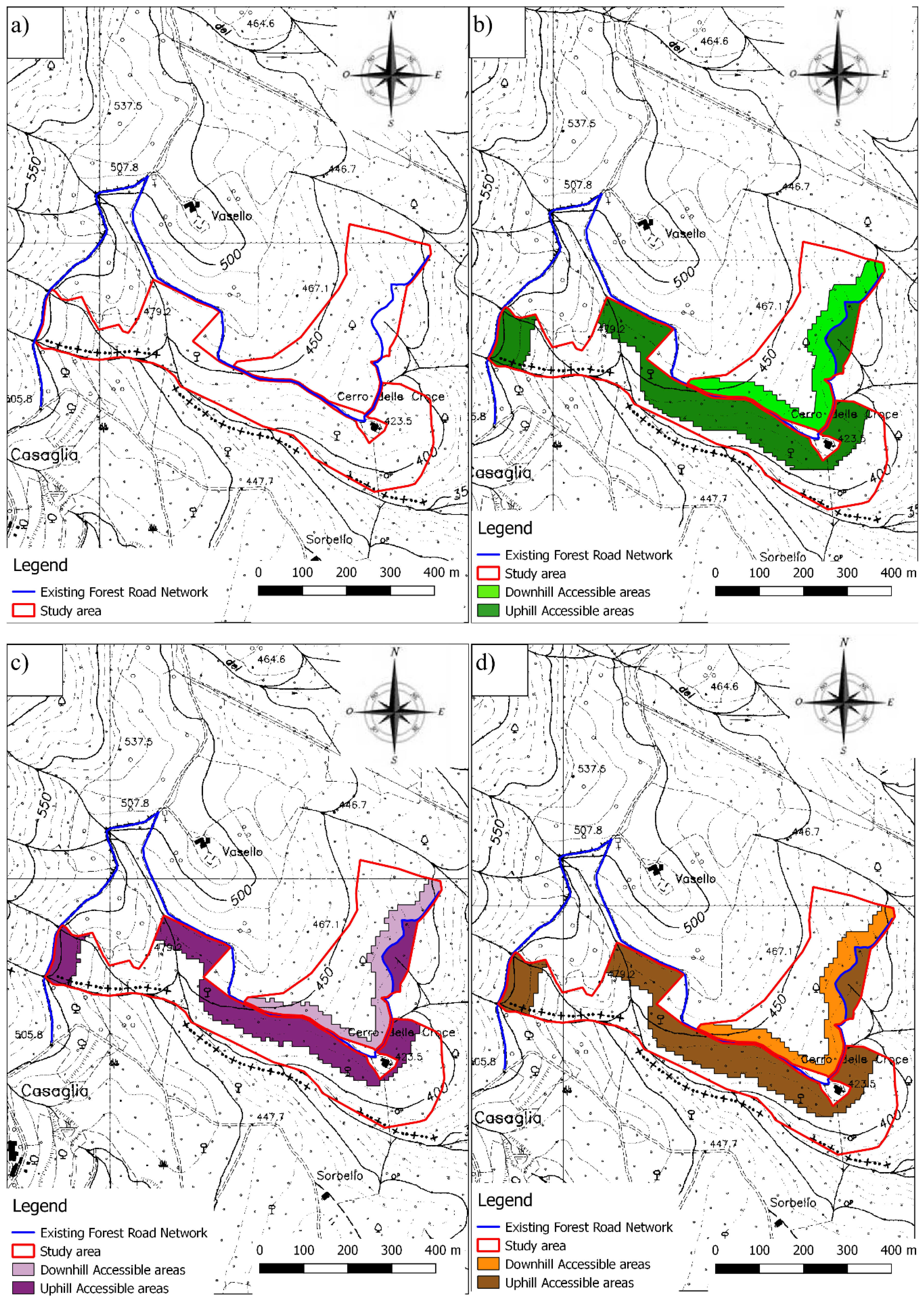
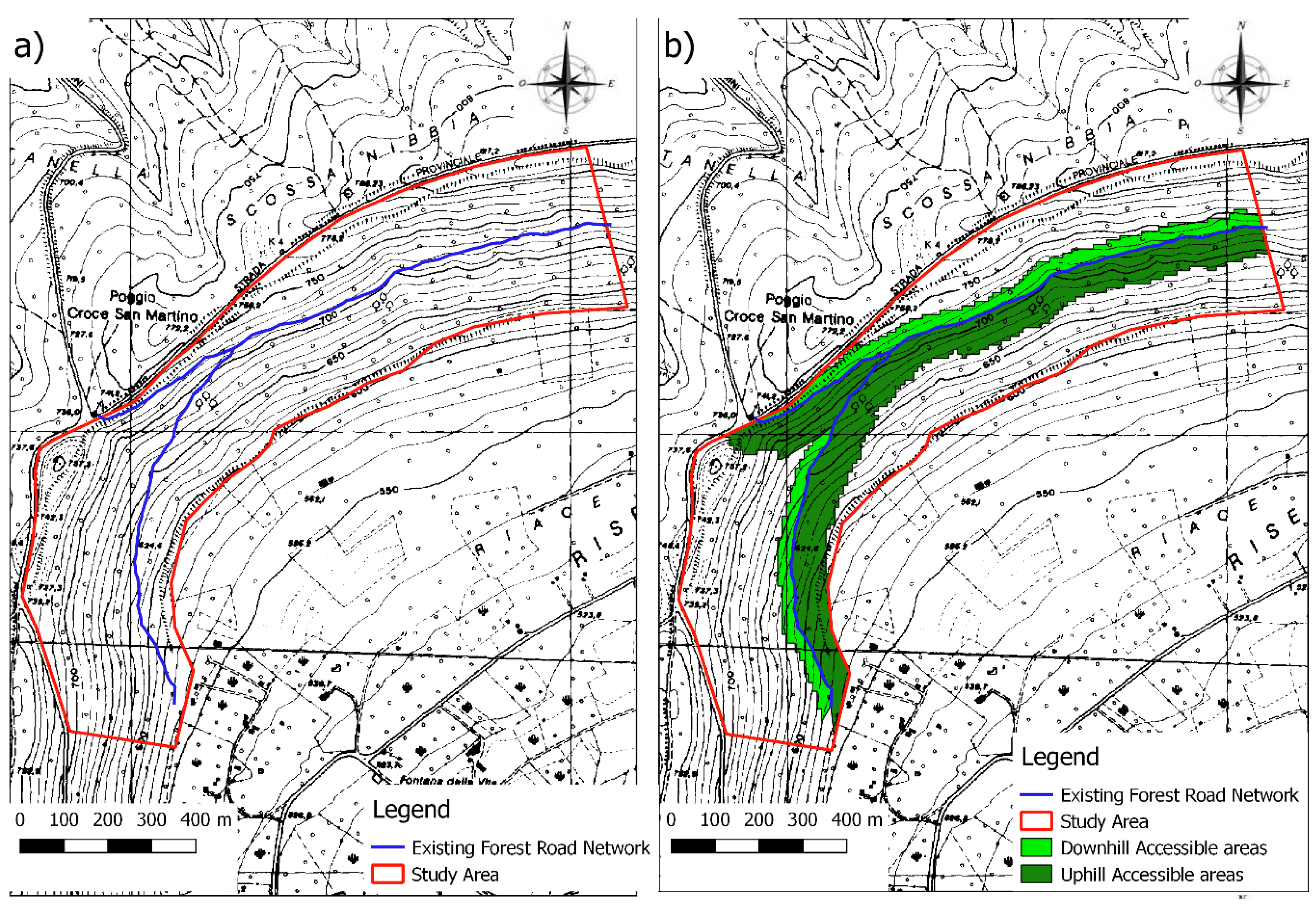
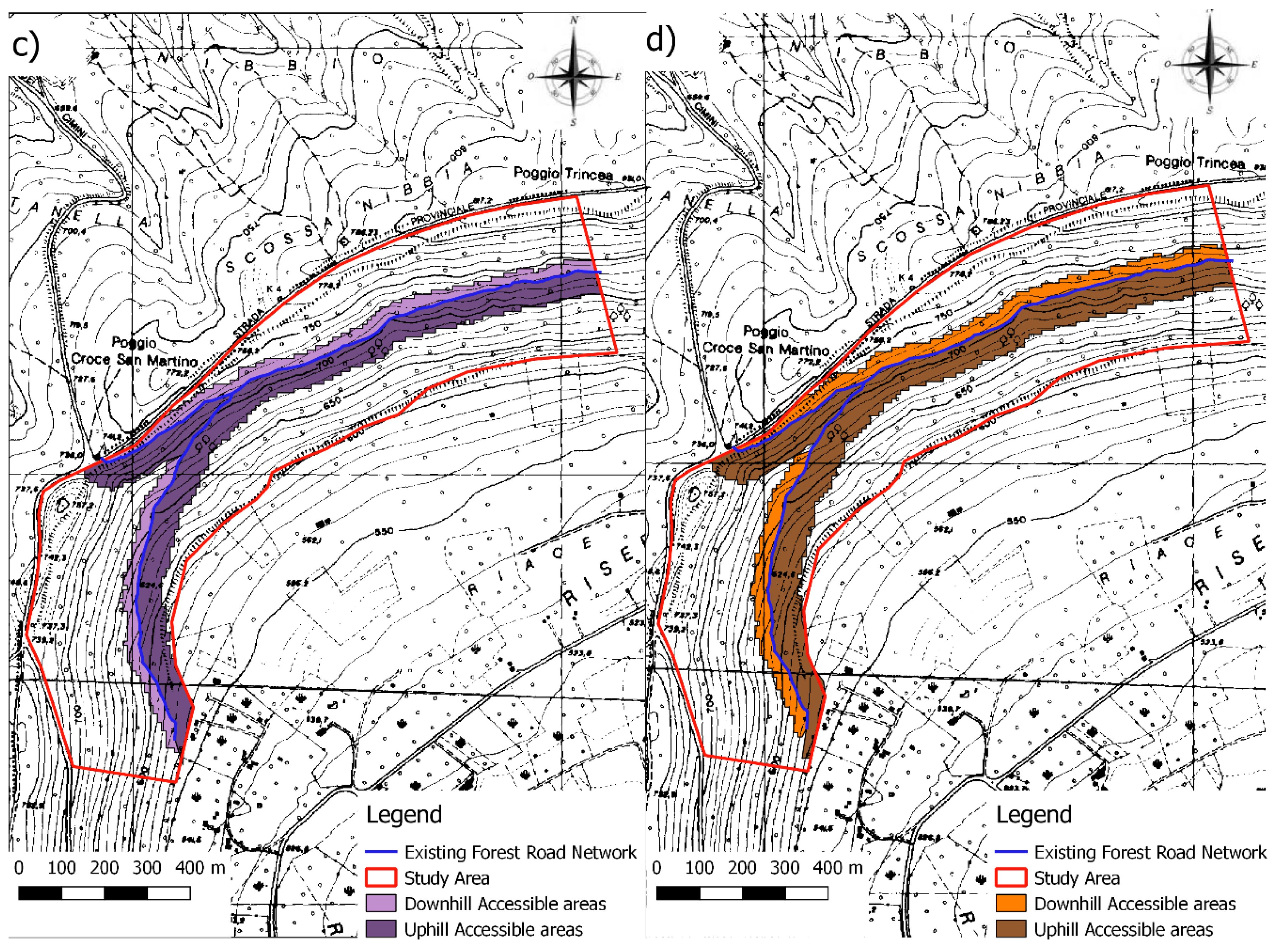
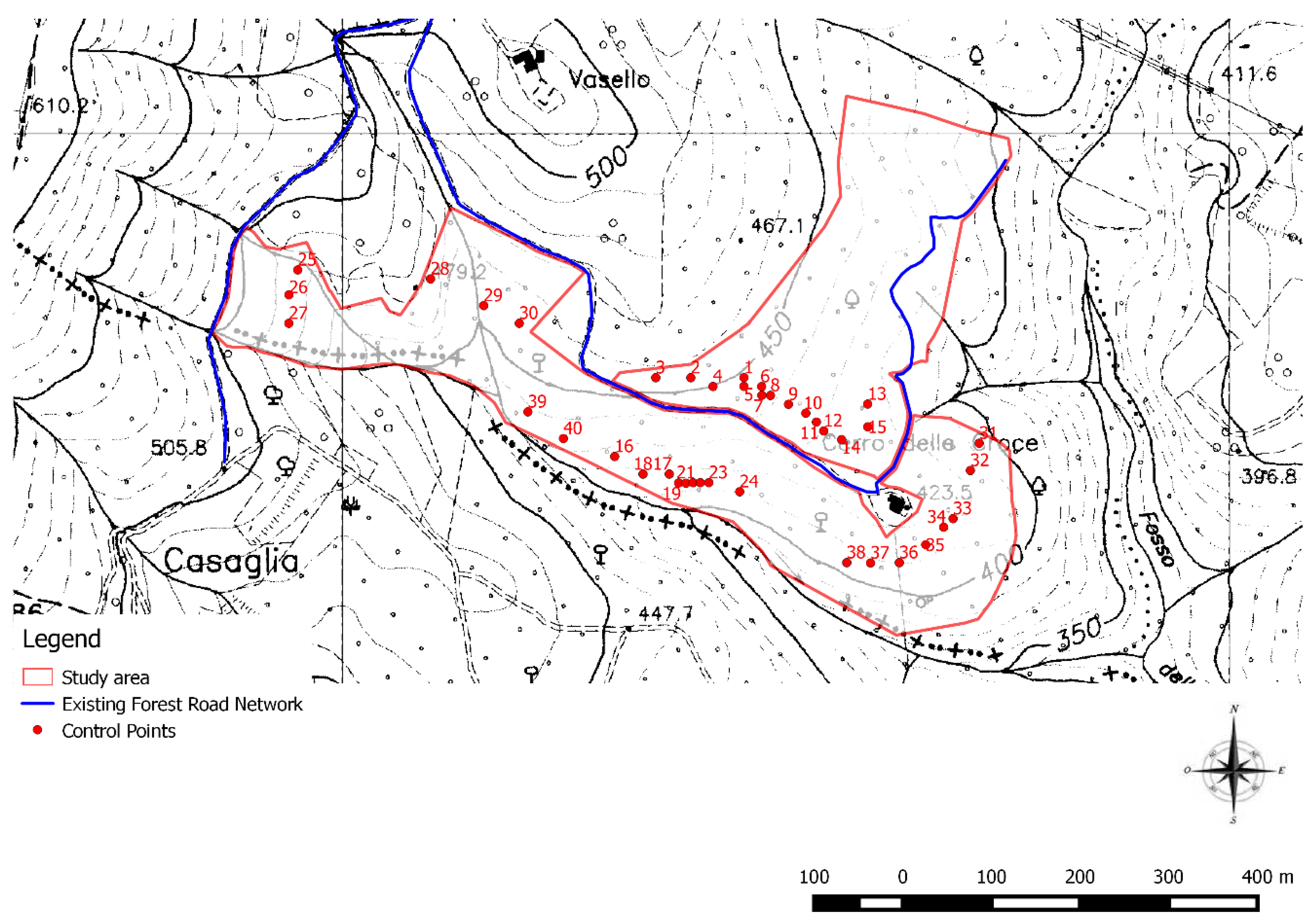
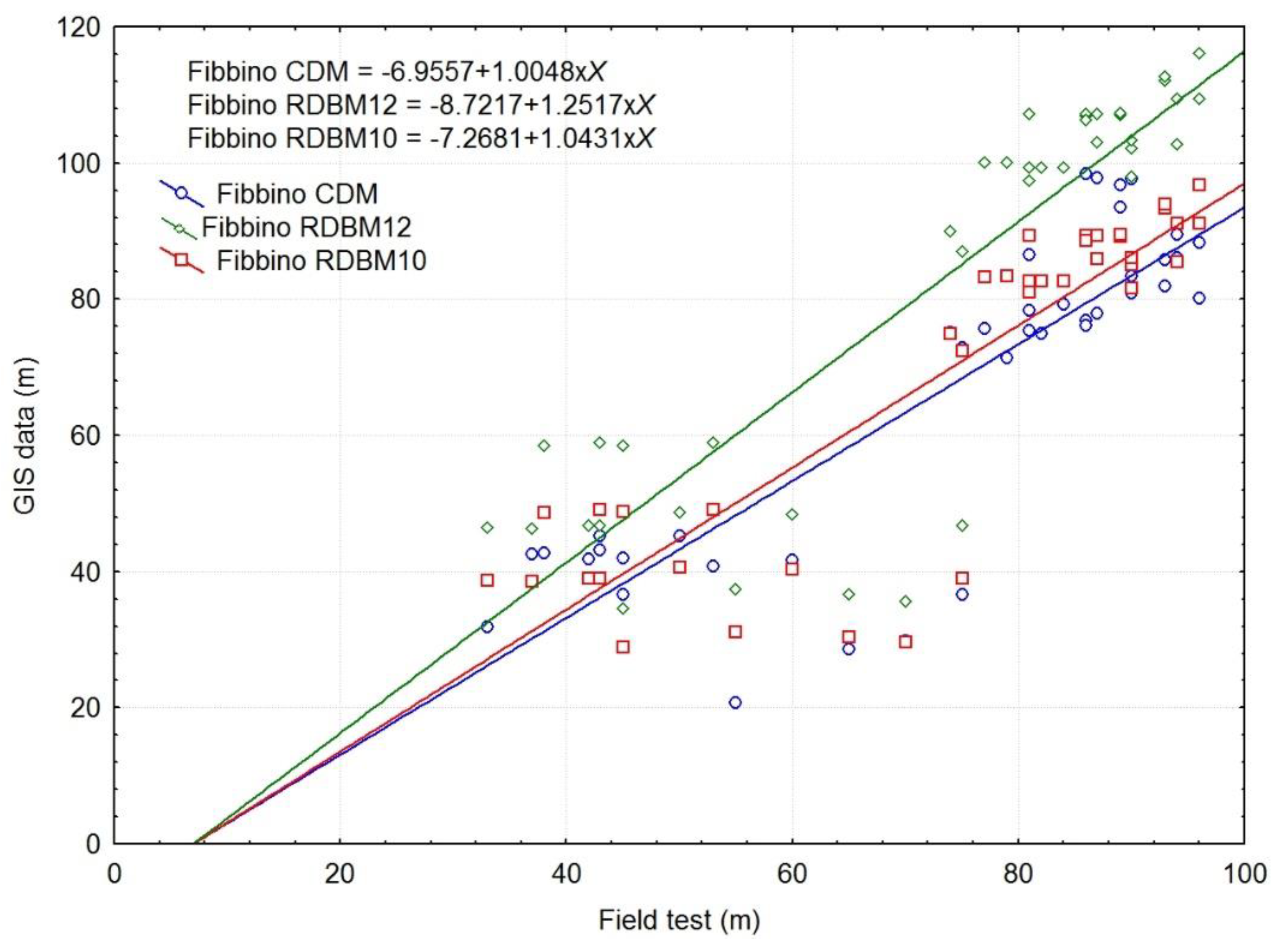
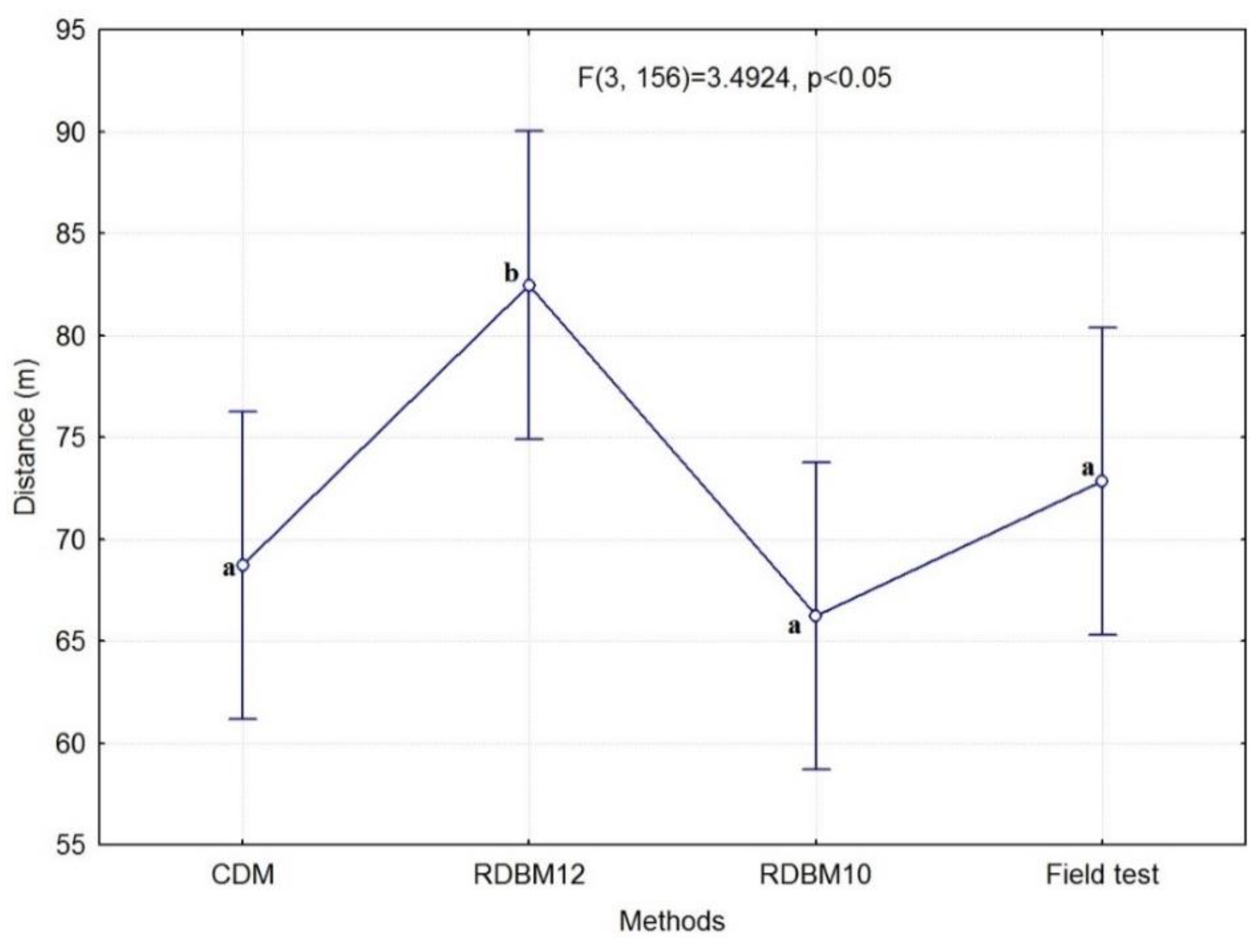
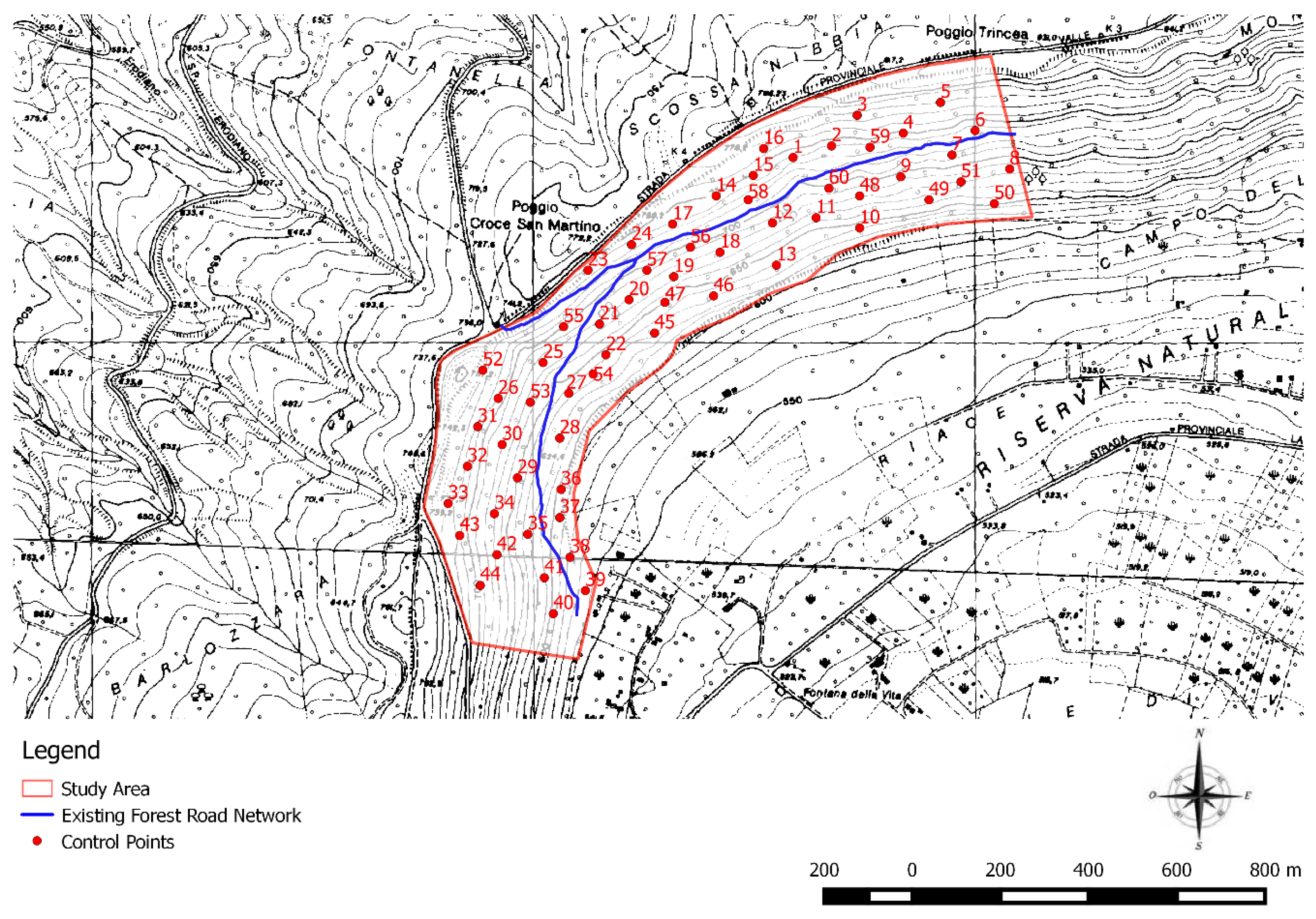
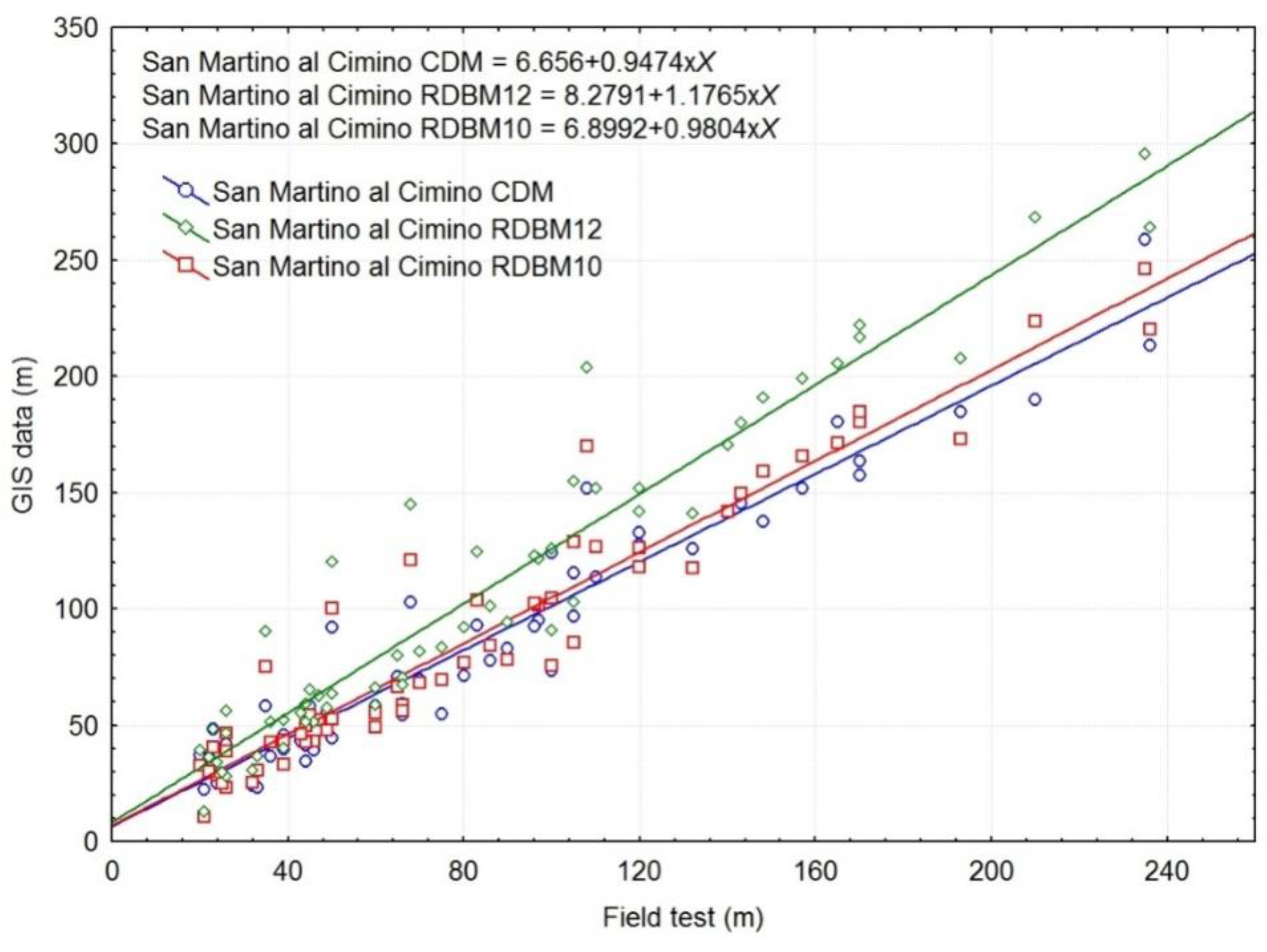
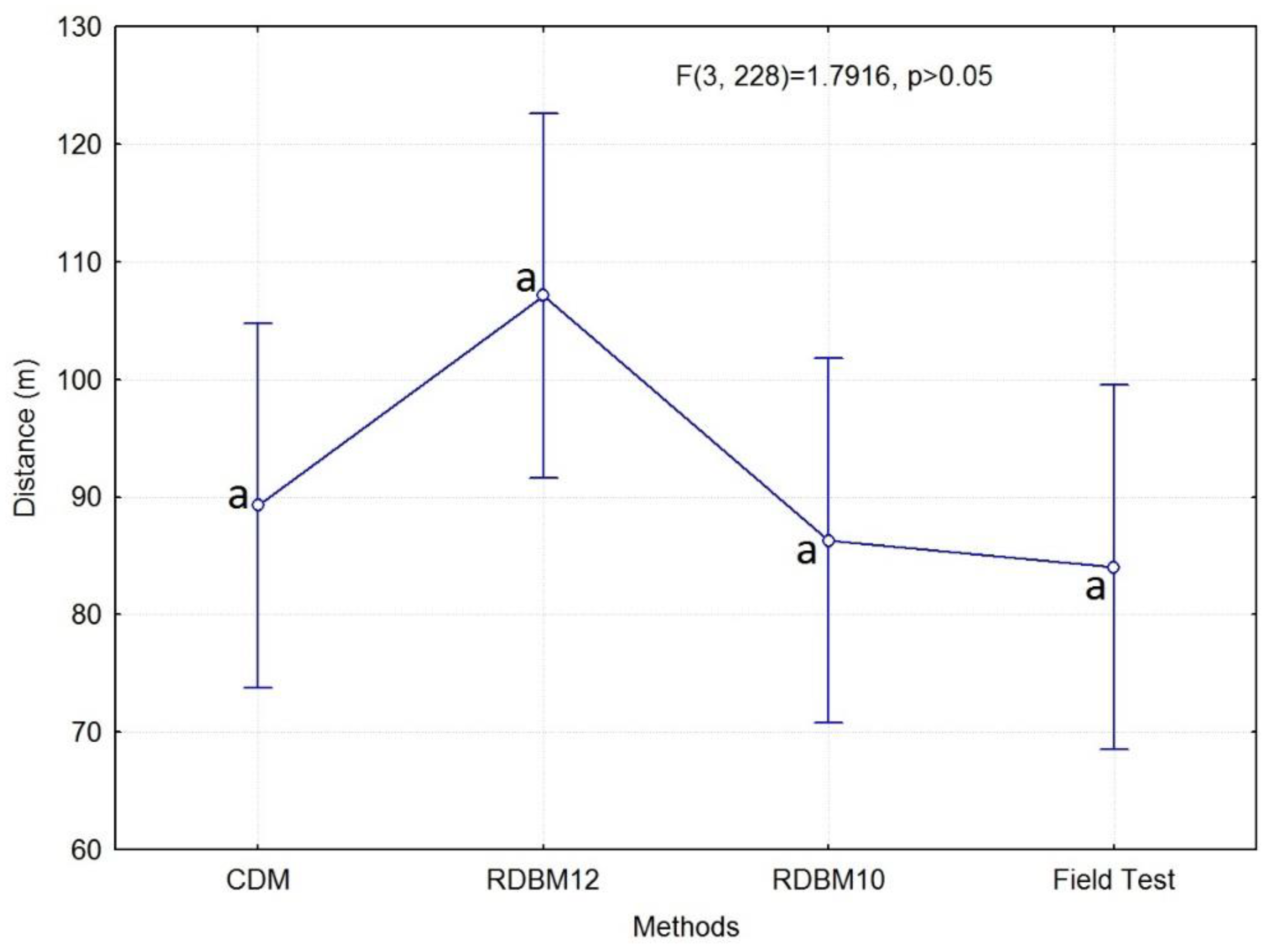
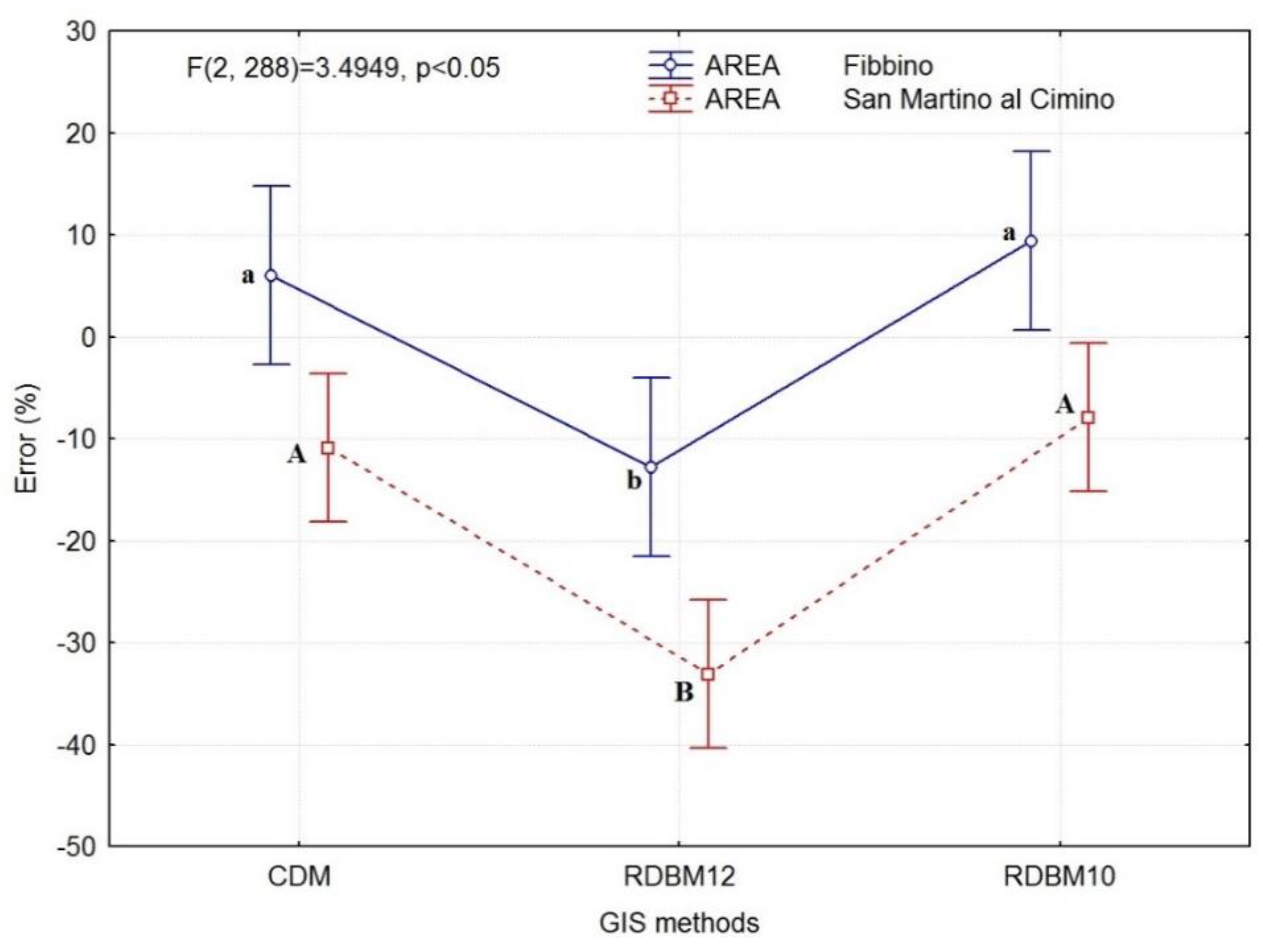
| Type of Road | Width [m] | Slope [%] | Maximum Curvature Radius in Hairpin Turns [m] | ||||
|---|---|---|---|---|---|---|---|
| Minimum | Prevalent | Optimum | Average | Maximum for Short Stretches | Maximum Reverse Slope * | ||
| Main | 3.5 | 5÷6 | 3÷8 | 10 | 14 | 10 | 10 |
| Secondary | 3.0 | 4÷5 | 3÷8 | 12 | 18 | 12 | 7 |
| Skid trail | 2.5 | 3÷4 | 3÷8 | 14 | 25 | 14 | 5 |
| Area | Road Type | Length [m] | Average Width [m] | Average Slope [%] | Maximum Slope [%] | Maximum Reverse Slope [%] | Minimum Curvature Radius in Hairpin Turns [m] |
|---|---|---|---|---|---|---|---|
| Fibbino | Secondary road for trucks | 2048 | 4.4 | 9 | 14 | 9 | 6.5 |
| San Martino al Cimino | Skid trails | 3300 | 3.5 | 12 | 18 | 10 | 5.4 |
| Area | Method | Existing Road Network Length [m] | Intervention Area [ha] | Density of Existing Forest Roads [m ha−¹] | Total Accessible Areas [ha] | Percent of Accessible Areas [%] | Accessible Areas for Uphill Extraction [ha] | Accessible Areas for Downhill Extraction [ha] |
|---|---|---|---|---|---|---|---|---|
| Fibbino | CDM | 2048 | 20.02 | 102 | 9.90 | 49 | 7.06 | 2.84 |
| RDBM12 | 2048 | 20.02 | 102 | 7.69 | 38 | 5.47 | 2.22 | |
| RDBM10 | 2048 | 20.02 | 102 | 9.13 | 46 | 6.66 | 2.47 | |
| San Martino al Cimino | CDM | 3300 | 61.60 | 54 | 21.32 | 35 | 15.15 | 6.17 |
| RDBM12 | 3300 | 61.60 | 54 | 17.64 | 29 | 12.16 | 5.48 | |
| RDBM10 | 3300 | 61.60 | 54 | 20.22 | 33 | 14.20 | 6.02 |
| Descriptive Statistics | Fibbino | San Martino al Cimino | ||||||
|---|---|---|---|---|---|---|---|---|
| CDM [m] | RDBM12 [m] | RDBM10 [m] | Field Test [m] | CDM [m] | RDBM12 [m] | RDBM10 [m] | Field Test [m] | |
| Mean | 66 | 82 | 69 | 73 | 86 | 107 | 89 | 84 |
| Minimum | 21 | 35 | 29 | 33 | 23 | 13 | 11 | 20 |
| Maximum | 98 | 116 | 97 | 96 | 259 | 296 | 246 | 236 |
| SD | 24 | 29 | 24 | 20 | 55 | 69 | 58 | 56 |
| Number | 40 | 40 | 40 | 40 | 58 | 58 | 58 | 58 |
© 2019 by the authors. Licensee MDPI, Basel, Switzerland. This article is an open access article distributed under the terms and conditions of the Creative Commons Attribution (CC BY) license (http://creativecommons.org/licenses/by/4.0/).
Share and Cite
Picchio, R.; Latterini, F.; Mederski, P.S.; Venanzi, R.; Karaszewski, Z.; Bembenek, M.; Croce, M. Comparing Accuracy of Three Methods Based on the GIS Environment for Determining Winching Areas. Electronics 2019, 8, 53. https://doi.org/10.3390/electronics8010053
Picchio R, Latterini F, Mederski PS, Venanzi R, Karaszewski Z, Bembenek M, Croce M. Comparing Accuracy of Three Methods Based on the GIS Environment for Determining Winching Areas. Electronics. 2019; 8(1):53. https://doi.org/10.3390/electronics8010053
Chicago/Turabian StylePicchio, Rodolfo, Francesco Latterini, Piotr S. Mederski, Rachele Venanzi, Zbigniew Karaszewski, Mariusz Bembenek, and Michele Croce. 2019. "Comparing Accuracy of Three Methods Based on the GIS Environment for Determining Winching Areas" Electronics 8, no. 1: 53. https://doi.org/10.3390/electronics8010053
APA StylePicchio, R., Latterini, F., Mederski, P. S., Venanzi, R., Karaszewski, Z., Bembenek, M., & Croce, M. (2019). Comparing Accuracy of Three Methods Based on the GIS Environment for Determining Winching Areas. Electronics, 8(1), 53. https://doi.org/10.3390/electronics8010053









